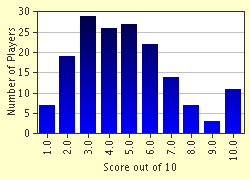Quiz Answer Key and Fun Facts
1. Which protein is known as the guardian of the genome?
2. What, in genetic terms is p53?
3. Which scientist coined the "two-hit" theory of tumour supressor gene inactivation?
4. Cancer is often associated with angiogenesis. What does this term mean?
5. Which commonly used cancer-fighting agent is associated with flu like symptoms?
6. What do chemotherapy agents generally target?
7. Genes can be methylated preventing their expression. What residues does methylation effect?
8. Which of these is NOT a tumour suppressor gene?
9. Which protein regulates p53?
10. VHL is another tumour suppressor gene. What is the best characterised function of VHL.
Source: Author
jimc
This quiz was reviewed by FunTrivia editor
crisw before going online.
Any errors found in FunTrivia content are routinely corrected through our feedback system.


